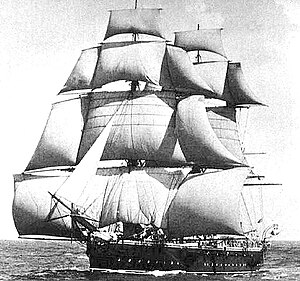Calypso-class corvette

HMS Calypso
|
|
| Class overview | |
|---|---|
| Name: | Calypso class |
| Operators: |
|
| Preceded by: | Comus class |
| Succeeded by: | None |
| Built: | 1883 - 1884 |
| Completed: | 2 |
| Scrapped: | 2 |
| General characteristics | |
| Type: | Screw corvette |
| Displacement: | 2,770 tons |
| Length: | 235 ft 0 in (71.6 m) pp |
| Beam: | 44 ft 6 in (13.6 m) |
| Draught: | 19 ft 11 in (6.1 m) |
| Installed power: | 4,023 ihp (3,000 kW) |
| Propulsion: |
|
| Sail plan: | Barque rig |
| Speed: | 13.75 kn (25.5 km/h) powered; 14.75 kn (27.3 km/h) forced draught |
| Complement: | 293 (later 317) |
| Armament: |
|
| Armour: | Deck: 1.5 in (38 mm) over engines |
The Calypso class comprised two steam corvettes (later classified as third-class cruisers) of the Royal Navy. Built for distant cruising in the heyday of the British Empire, they served with the fleet until the early twentieth century, when they became training ships. Remnants of both survive, after a fashion; HMS Calliope in the name of the naval reserve unit the ship once served, and HMS Calypso both in the name of a civilian charity and the more corporeal form of the hull, now awash in a cove off Newfoundland.
The class exemplifies the transitional nature of the late Victorian navy. In design, materials, armament, and propulsion the Calypsos show evidence of their wooden sailing antecedents, blended with characteristics of the all-metal mastless steam warships which followed. Their appearance and layout was similar to the "pure" sailing corvettes, with boiler rooms, machinery spaces, ventilators, and a flue added. Of iron and steel construction, they had coppering over timber below the waterline, as did older wooden vessels. Their armament was not in turrets or barbettes, but arranged in a central broadside battery, with the four largest guns on sponsons to give larger arcs of fire. And they had both a powerful steam engine and an extensive rig of sail. They formed the last class of sailing corvettes in the Royal Navy.
Calypso and Calliope made up the Calypso class, a successor to the successful Comus class, all designed by Nathaniel Barnaby. The vessels were screw corvettes or small cruisers, and were among the Royal Navy’s last sailing corvettes. They supplemented an extensive sail rig with a powerful engine.
In profile they resembled older wooden sailing frigates, from bowsprit to stern gallery. The ports in the gallery were false, and there were no quarter galleries. Other differences included a nearly straight stem, a shorter battery, and sponsoned guns on the corners of the battery. Above the decks they had a full suite of masts and spars, standing and running rigging, and square and fore-and-aft sails. The shrouds were not attached to chainplates on the outside of the hull, as in older vessels, but to the inside of the bulwarks. Interposed between the masts and rigging were the ventilators and stack of the steam plant. In plan the ships shows decks common to older sailing cruising vessels, including a poop deck at the rear, the overhang of which sheltered a wheel on the quarterdeck below. The guns were all on the highest continuous deck; the battery was shorter than on wooden vessels with full-length gun decks, as the class carried fewer (although more powerful) guns than corvettes and frigates in the classic age of sail; all guns were carried in the waist of the ship, between the poop and forecastle.
...
Wikipedia
